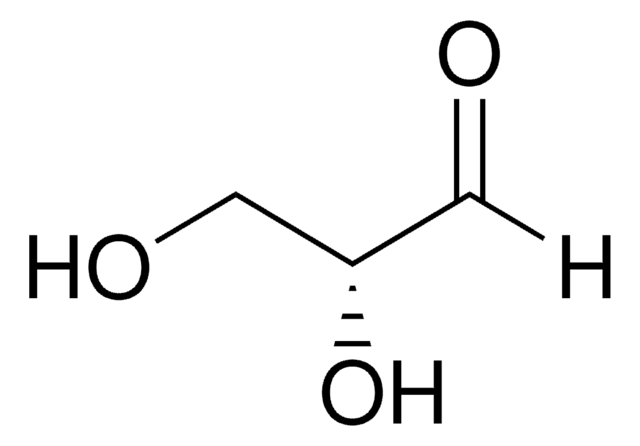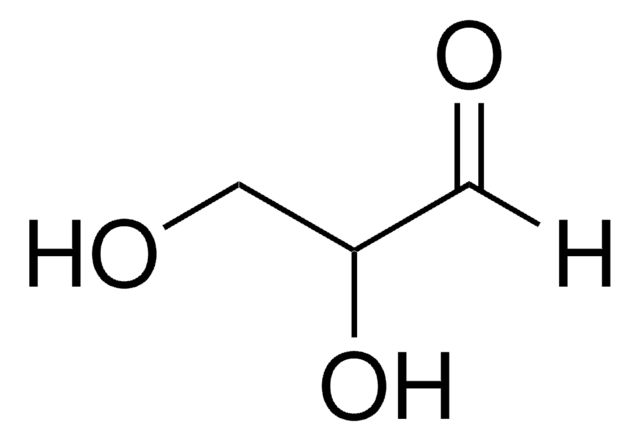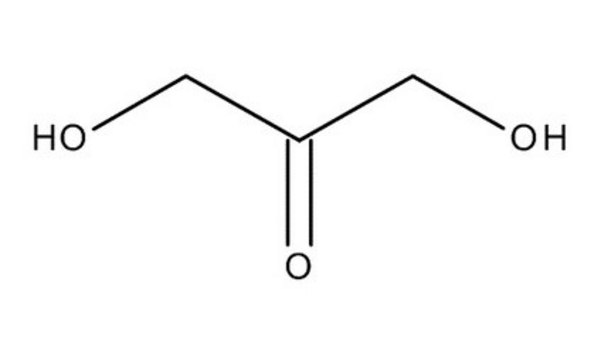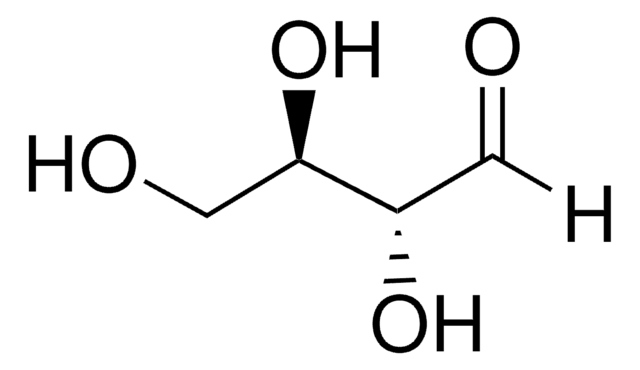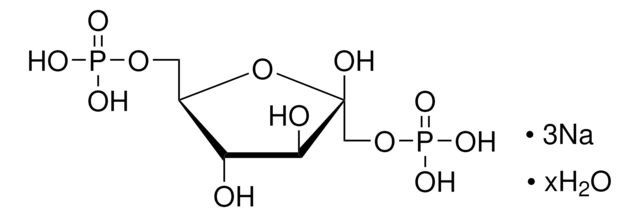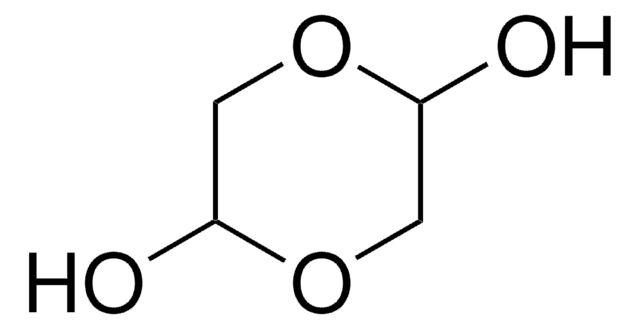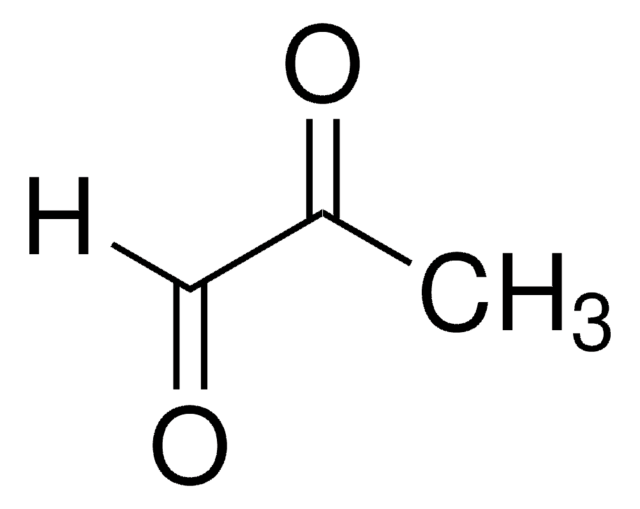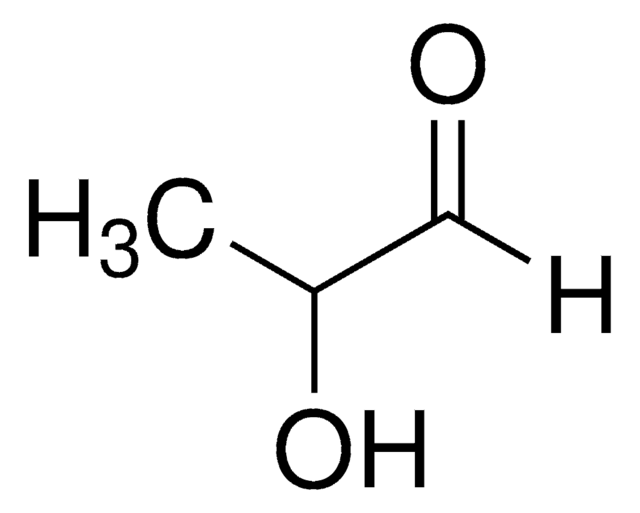73572
L-(−)-Glyceraldehyde
≥90% (HPLC)
Synonym(s):
(2S)-2,3-Dihydroxypropanal
Sign Into View Organizational & Contract Pricing
All Photos(1)
About This Item
Empirical Formula (Hill Notation):
C3H6O3
CAS Number:
Molecular Weight:
90.08
Beilstein:
1720475
EC Number:
MDL number:
UNSPSC Code:
12352204
PubChem Substance ID:
NACRES:
NA.32
Recommended Products
Quality Level
Assay
≥90% (HPLC)
optical activity
[α]/D -11.0±3.0°, c = 2 in H2O (after 24 h)
solubility
water: soluble 30 g/L at 18 °C
storage temp.
2-8°C
SMILES string
OC[C@H](O)C=O
InChI
1S/C3H6O3/c4-1-3(6)2-5/h1,3,5-6H,2H2/t3-/m1/s1
InChI key
MNQZXJOMYWMBOU-GSVOUGTGSA-N
Looking for similar products? Visit Product Comparison Guide
Application
- L-Glyceraldehyde Inhibits Neuroblastoma Cell Growth via a Multi-Modal Mechanism on Metabolism and Signaling.: This research highlights the inhibitory effects of L-Glyceraldehyde on neuroblastoma cell growth, revealing its impact through multiple pathways in metabolism and cell signaling (Forbes M et al., 2024).
Biochem/physiol Actions
L-(-)-Glyceraldehyde is an important intermediate in carbohydrate metabolism.
Packaging
Bottomless glass bottle. Contents are inside inserted fused cone.
Other Notes
To gain a comprehensive understanding of our extensive range of Monosaccharides for your research, we encourage you to visit our Carbohydrates Category page.
Storage Class Code
10 - Combustible liquids
WGK
WGK 3
Flash Point(F)
233.6 °F - closed cup
Flash Point(C)
112 °C - closed cup
Choose from one of the most recent versions:
Already Own This Product?
Find documentation for the products that you have recently purchased in the Document Library.
Nina Richter et al.
Biotechnology and bioengineering, 106(4), 541-552 (2010-03-04)
A whole-cell catalyst using Escherichia coli BL21(DE3) as a host, co-expressing glycerol dehydrogenase (GlyDH) from Gluconobacter oxydans and glucose dehydrogenase (GDH) from Bacillus subtilis for cofactor regeneration, has been successfully constructed and used for the reduction of aliphatic aldehydes, such
Cancer biomarker AKR1B10 and carbonyl metabolism.
Balendiran, G. K., et al.
Chemistry & Biology, 178, 134-137 (2009)
David A Korasick et al.
Journal of molecular biology, 431(3), 576-592 (2018-12-24)
Heterokonts, Alveolata protists, green algae from Charophyta and Chlorophyta divisions, and all Embryophyta plants possess an aldehyde dehydrogenase (ALDH) gene named ALDH12. Here, we provide a biochemical characterization of two ALDH12 family members from the lower plant Physcomitrella patens and
Nina Richter et al.
Chembiochem : a European journal of chemical biology, 10(11), 1888-1896 (2009-07-07)
The acetic acid bacterium Gluconobacter oxydans has a high potential for oxidoreductases with a variety of different catalytic abilities. One putative oxidoreductase gene codes for an enzyme with a high similarity to the NADP+-dependent glycerol dehydrogenase (GlyDH) from Hypocrea jecorina.
Zhou Chen et al.
Enzyme and microbial technology, 133, 109456-109456 (2019-12-26)
Dihydroxyacetone phosphate (DHAP)-dependent aldolases demonstrate important values in the production of rare ketoses due to their unique stereoselectivities. As a specific example, we developed an efficient Escherichia coli whole-cell biocatalytic cascade system in which rare ketoses were produced from abundant
Our team of scientists has experience in all areas of research including Life Science, Material Science, Chemical Synthesis, Chromatography, Analytical and many others.
Contact Technical Service